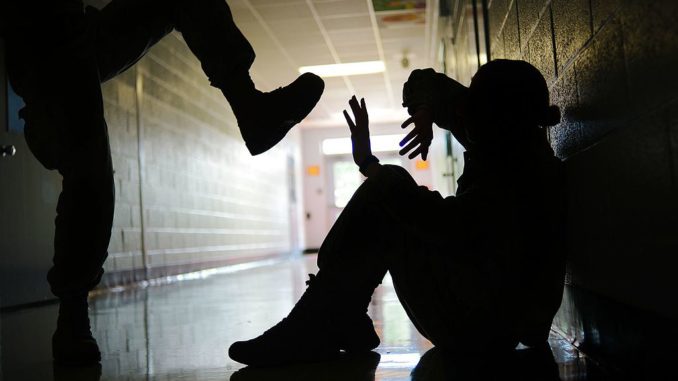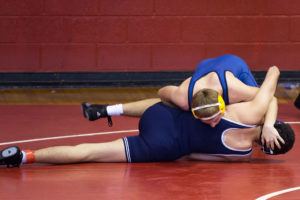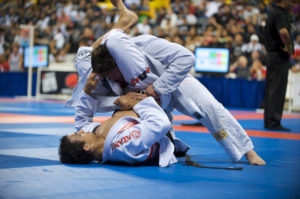
Warning: If you are looking for a short and entertaining politically-correct article about the best martial arts to bully-proof your child, this isn’t it. There are other articles out there in internet land on this topic which are short and entertaining to read. However, if you are looking for an article that digs deep and tackles the nitty gritty of each of the five martial arts I recommend your child should learn to protect himself from bullies, this is the one. This is a very long article and I will get a bit technical as I nerd out on the strengths and weakness of five martial arts I have chosen, and sometimes compare one to another. So if this is this is your thing… dig in.
Martial Arts will help bully-proof your child
Bullies giving your kid a tough time in school? Has your kid ever come home beat up? Afraid bullies or other unpleasant characters might assault or take advatage of your child?
First, let’s get things straight. Learning to fight back is necessary. Some bullies pick on or even assault others kids for the sheer pleasure of it. No reasonable amount of talking to them will work. Ain’t nobody got time for that. Except maybe their momma and dada. So sometimes, if your child has been punched in the gut too many times, he’s got to hit back sometime. Some martial arts are better at teaching your child to fight and defend himself than others. This article has my opinions on which martial arts are the better ones. I don’t want to waste on my or your time because of political correctness here, saying all martial arts are equal and crap like that. Ain’t nobody got time for that.
In short, in this article I’ll tell you my opinion: Which martial art will most likely make my child more effective in an actual fight?
Should I even be teaching my kid how to fight?
Lots of people believe in non-violence. This is all good. The internet world is full of good advice for law-abiding pacifist parents. And I agree, the best way to win a fight is to avoid it or talk it out. However, sometimes best efforts fail and your child could finds himself cornered in the bathroom being turned into a punching bag by a bully. Martial arts can save him from a lot of physical and pyschological harm, which he could carry his whole life. Some children have even been killed by bullies at school.
Martial Arts teaches confidence, character, discipline and promotes fitness. Bullies and the other bad boys at school love to prey on the timid and weak. And, if your child unfortunately find him or herself in a situation where there is no other recourse than self-defense, it would be awesome if they have the skills to minimize or avoid injury altogether. Maybe even kick the bully’s ass.
So yeah, teaching your kid how to fight is an important skill to bully-proof your child. If you’re still not convinced, you can continue teaching him pacifism and keep talking to the school’s teachers for six hours a week about your problems. But if want to read on and learn, there’s a lifetime of martial arts and real world experience which backs up this article.
How Did I Choose The Martial Arts I recommend?
Martial arts aren’t equal. That’s actually what makes the world of martial arts so valuable. Some are practical for self-defense and street fighting. Others focus more on traditional skills and values. Some are oriented towards only fighting one opponent. Some have skills which will help you defend against multiple attackers. Of course I’d like to say that proficiency in any martial art is to be admired, and just because a person is a practitioner of a martial art not listed here, doesn’t mean they can’t beat other people up in ten seconds flat, maybe even me. I respect all martial artist. Except maybe for those weird guys on YouTube who claim to have energy death touches or something. Those guys are frauds. But I digress.
So anyway, these are the factors I looked into when I recommended the martial arts:
Focus on Hand-to-hand Combat
I’m only evaluating martial arts and combat sports that specialize in hand-to-hand combat. No matter where you are, in the toilet, in school yard or in a freakin’ science lab, you’ll have two fists to punch and two feet to kick ass. I didn’t include any martial arts that deal with weapon, like the stick and knife wielding fighting arts like arnisi. I’d rather not discuss teaching kids how to weild sticks, knives or nunchakus. Some smart asses will probably say, it’s better to learn how to wield weapons or crap like that and hand-to-hand fighting is useless. To those smart asses, I’d say “Get a life.”
Combat Effectiveness
Martial arts systems are influenced by their traditions and competition systems. This makes some more suited for a real brawl than others. For example, let’s compare the Korean art of Taekwondo, which uses a point system to determine the winner in their competitions. Because of this many, Taekwondo coaches emphasize the flicking speed of a kick. A Muay Thai low kick instead focuses just on crushing your opponents legs.
One or Multiple attackers
Whether a martial art is meant to handle one or multiple attackers is one of the factors I considered. Some martial arts have techniques which will be a challenge to apply when you have more than one attacker, such as Brazilian Jiujitsu. Some disciplines will help you handle several people coming at you at once, such as Krav Maga.
Non-combat aspects of the martial arts
Some disciplines purely focus on the combatative aspect, we call them combat sports, like boxing and wrestling. Other fighting disciplines are deeply steeped in tradition and character building, like Judo and Aikido. I’ll be discussing that here too. Yes, I’ve included “combats sports” here too. So without further ado…
MFTWM Top 5 Martial Arts to Bully-Proof Your Child
With a whiteboard, pizza, and a night-long discussion, the editorial team has come up with a list of the 5 martial arts, and combat sports that we can consider martial arts, that will help bully-proof your child. So here’s the real cheese. What are these to 5? Read on….
Wrestling

Hold on silly, I’m not talking about the fake entertainment wrestling, like WWE. I’m talking about the wrestling they teach at schools and universities. Man’s oldest sport. The Olympic sport. The one where they wear singlets and grapple and suplex each other into oblivion. I ain’t talkin’ about no gi grappling either. I’m talking about good old wrestling. You know what I’m sayin’.
Wrestling is the most natural in for of fighting. Bears wrestle, dogs wrestle, people wrestle. Kids can also get pretty good at wrestling pretty early. Kids as young as four or five years old can start training. Many schools have programs for folk style or collegiate wrestling, and Olympic-style wrestling. There are many programs available which start kids wrestling young. In fact, in some countries like the US, someone who’s just starting out competitive wrestling as an adult tends to be the exception rather than the rule.
To my mind, wrestling is good for your child’s self-defense for two reasons. First, Wrestling teaches you to keep a dominant position. Second, Wrestling will teach you to prevent being taken to the ground.
Aruguably, wrestling will build your child’s physique the fastest. All this tackling, throwing and plain ‘ol wrasslin’ is extremely physically demanding. I’d consider wrestling even more physically demanding than MMA.
Wrestling can definitely make your kid a tough guy, tackling at will, or successfully defending a tackle at ease. There a few things easier in the world to a wrestler than defending a takedown attempt from a non-wrestler. This means if your kid is a wrestler, a bully probably won’t be able pin him to the ground and smash up his face, or do what ever bad people do.
Limitations of Wrestling
But of course, wrestling is far from being a very comprehensive or complete fighting system. There are some drawbacks learning only wrestling, if your aim is to bully-proof your child. Obviously, wrestling doesn’t have any kicks or punches. Sometimes, you just have to pummel a bully with your fists to get the message across.
There are a couple of moves in wrestling which don’t make sense in a fight, like ankle laces, or gut wrenches, which were meant to give an athlete more points on the mat rather than cause damage an opponent or strengthen one’s position.
I think another often overlooked aspect of learning how to fight, is learning not to be overly afraid of punches and kicks, and learning to take a few without being rattled. Even in MMA, I’ve seen great wrestlers get totally flustered in stand-up striking fight, and end up being toyed around with by someone who is more confident trading punches and kicks standing up.
MFTWM Expert Tips: Don’t forget to get your child ear protectors, unless you want him or her to develop cauliflower ears which will last a lifetime.
Boxing
My dad always used to tell me that boxing is immediate, meaning that in a fight where no weapons are involved, there is almost always an opportunity for a couple of punches to be traded at the start. The ability to hit hard, fast, and accurately is paramout in boxing, and there’s no substitute for being able to out punch someone .
Any parent that wants his kid to learn martial arts for self-defense should consider boxing. Especially for little kids who don’t have the coordination to kick properly yet. And boxing isn’t just the ability to punch well. It’s also the ability to take a punch, dodge a punch, pace your self-during a fight, picking your shot, and whole host of other important skills.
We’ve might have heard other self-defense and martial arts experts scoff at striking arts like boxing since “most fights end up on the ground”. Perhaps this is statistically true according to so and so study, but who know? This is not the entire truth. By simple observation we can tell that for lots of fights end standing up, with the better boxer smashing up or knocking out the other. A good combination, or even a good hook to the chin is all it takes to bring a bad bully down. In any case, even if most fights as some say end up on the ground, they always start with both fighters standing up.
Also, it is definitely not in your child’s interest to engage in grappling his opponent to the ground if he has more than one opponent, or he wants to get away as quickly as possible. Being attacked by several opponentsd at once, it makes sense to keep your feet under you and stick to well-placed punches.
A Concern on Hard Sparring
I hold reservations about letting my kids doing lots hard sparring, especially in boxing. In boxing, for mucb of the time you’re standing trading blows to the head. This problem with hard sparring is worse when you have a lot of hot-blooded kids in the class. Boys will be boys. While all kids I believe should do hard sparring once in a while to simulate engaging in an actual fist fight, your kid has to be ready for it. And he’ll be ready only once your child believes he his, not the time you believe he is. I don’t know everything that researchers say about boxing, but I will absolutely not let my kids be subjected to any sport that involves regular pounding on the head. It is very well know that minor concussions do in the long term in sports like football affect your cognitive abilities later in life.
In the meantime, children who are into boxing can do lots of bag work, mit work, and maybe a little light sparring on the side.
By the way, one thing you do have to watch out for is protecting a young boxer’s fist. The strength of one’s punch usually increases much faster than the bones and ligaments in your fist get tough. And a kid who can punch really hard could easily break his wrist or hand hitting a hard surface, like the crown of someone’s head.
Limitations of Boxing
Boxing of course is far from being complete. It does not have any form of kicking, throwing or grappling. The clinch one learns in boxing might even be counter-productive, since it encourages hanging on passively rather than jostling around for more leverage or a dominant position. Once a boxer is on the ground, perhaps tackled or tripped in a fight, his skills go out the window.
MFTWM Expert Tips: Once your kid is old enough, I’d say around 9 or 10, be sure he learns how to wrap his own hands. There is nothing more sorry in the world of boxing than the sight of a trainer wrapping his student’s hands.
Muay Thai
If I had to choose just one martial art to teach striking to a child it would be Muay Thai. The skill set emphasized in muay thai is the most well-rounded and practical. More or less all the arguments I put forward for boxing apply to Muay Thai as well, but with kicks, elbows, and knees. School yard fights can get pretty messy. So skills with his or her elbows and knees can get pretty useful. When kids are little, their punches don’t really have that much oomph behind them to hurt each other much. Elbows and knees though can cause a lot of damage.
I like low kicks in Muay Thai. Unlike some of the more flashy striking arts, like Taekwondo, low kicks are not neglected in muay thai. In fact low kicks are a regular part of a muay thai practitioner’s arsenal. Low kicks can be effective in a real fight, as compared to high kicks which could off balance your child and give your bully a chance to topple him. Unlike high kicks that can damage an opponent which to some might a higher level of skill, low kicks at even basic levels of the sport, can be learned relatively much more effectively, which is good if your child still lacks coordination.
While you can do some boxing mitt work for really, really small kids, in muay thai around 6-8 years would be the youngest they start your kid before they have the coordination to kick well.
Concern with Hard Sparring
Like with boxing, I have the same concerns with hard sparring for young kids with Muay Thai. While I believe every child doing martial arts, when he thinks he is ready, should engage in hard sparring on rare occasions. Doing forms and kata for four hours a day, like in some other more traditional martial arts ain’t worth much in a real fight if this isn’t coupled with any real fighting experience. There’s no substitute for just getting there fighting when learning how to fight. But I just don’t believe it should be with any regularity.
Technical point on Muay Thai clinch
One technical point I’d like to talk about is the child’s learning of the muay thai clinch. In a a professional MMA arena, someone who specializes in wrestling will be able to neutralize the muay thai clinch. However, the muay thai clinch can devastating against a relatively unskilled opponent. This will include a typical schoolyard school fight. If they are generally the same size and strenghth, a muay thai clinch can be used to effectively control and batter a bully with knees to the head, stomach, and groin.
MFTWM Expert Tips: Don’t be shocked if your kid comes home with shins black and blue with bruises. Working on the heavy bag is enough to bruise up your shins, especially if you’re new to the sport. He might even come home with bruised up thighs from leg kicks if they do sparring. As long as your kid is having fun, it should be all good.
Brazilian Jiu-jitsu

Of all the grappling martial arts and grappling sports, Brazilian Jiujitsu or BJJ has hands down the most comprehensive skill set. There are many different schools of thought in BJJ. This is in comparison to more traditional art like say Judo wherein most clubs still have close ties to the martial art’s traditional Japanese values. BJJ practitioners, especially the stars of the martial art, often pride themselves being practical and inventive in their techniques. There is a culture of ingenuity in BJJ that is not present in some other martial arts which allows its techniques to constantly develop. Perhaps, because BJJ is also used as a sport in both BJJ tournaments and MMA tournaments, and because it is a relatively young and developing sport, there is much room for more effective techniques and variations to old techniques to be tested.
This “New World” culture of competition, pragmatism and ingenuity in BJJ is very evident. When I first was exposed to grappling sports as a teenager in the 1990’s, a number of techniques we used, such as the rear-naked or the guillotine choke, were a bit different to how many BJJ practitioners do it now. They’re a lot more nuanced and effective now. Today, you can go on YouTube and find numerous top-rated BJJ practictioners sharing their own variations and tips on various techniques. There are still a lot of techniques being refined, and thrown onto the competition mats, in a bid to find a more effective way to do things. In fact, in the past two decades, several new BJJ techniques have even popped up and gained popularity like the berimbolo, and the Peruvian necktie.
Gi and No Gi
The gi is the Japanese style kimono uniform practitioners of martial arts wear. BJJ is taught both with no gi or gi. Training with gi is considered as more standard, though. I’d like to draw a contrast with Judo where the sport does not study techniques no gi, in BJJ, most coaches will teach both gi and no gi BJJ classes within the same week. This is important for those with self-defense in mind. If your child wants to learn a martial art, it is important he should be able to use the techniques whether or not the bully assaulting him, is wearing thick clothing or not. As Judo practitioner I know, let’s call him Jim, as a teenage kid would sometimes rip the sleeves of some other kids short sleeve t-shirts in fights when trying to apply Judo techniques, since Jim would have no gi to hold on to.
Growing BJJ fan base
BJJ is the one of the most popular and fast-growing martial arts today. Because of the martial art’s popularity, and perhaps because the sport is relatively easy-on-the-body, compared to MMA, muay thai or even wrestling, competing in BJJ is very popular. There will be many opportunities to compete for your child should he decide to take up BJJ. Many major competitions having divisions for kids and white belts. There are even competitions for children as young as four years old. Entering competitions, regardless of the results can greatly make your child more confident with his abilities, and be a reward in itself to continue improving in the martial art of his choice.
Limitations of Brazilian Jiu-jitsu
Of course, just like in any martial art, there is a disparity between the skills your child learns in the gym and dojo and the skills he can use to defend himself against a bully or on the street. For one, BJJ is a grappling art, so of course there are no striking skills taught in BJJ. Some BJJ techniques rely on using your opponents gi, such as some chokes. These obviously can’t be applied in all situations. But as mentioned, there is no gi BJJ. Secondly, here are also some techniques meant for competition but might not be effective in a street fight. These are techniques like “guard dropping” or “butt scooting”. To some martial arts purists, there is nothing that brings tears in their eyes more to more than seeing two grapplers both jumping guard.
All in all though, most of the skills in BJJ can directly translate to self-defense situations.
MFTWM Expert Tips: There is a big difference between the skill set which Brazilian Jiujitsu practitioners focus on and the skill set focused on by practitioners of BJJ’s more traditional sibling Japanese Jiujitsu. While most of what you’ll find in major cities are Brazilian Jiu-jitsu schools, there are still an number of traditional Japanese Jiujitsu schools around.
Judo
The skill set which Judo teaches is different compared to BJJ. While Judo is the epitome of throwing arts, it is less comprehensive than BJJ in the sense that it covers less situations. But I definitely think Judo is a great sport to bully-proof your child. In in some aspects of fighting, Judo can be more practical for self-defense situations, such as in a school yard fight with a bully, than either Wrestling or BJJ.
Emphasis on the “Ippon”
Judo focuses on the concept of scoring one good throw to end the match or fight. This is embodied in Judo’s traditional training methods and the rules of competitive Judo. The aim is to do one throw, but do it damn well, so even if that means you have to practice just one or two throwing techniques literally a hundred times a day, you go do it. In other words, this art’s philosophy is that having one well-executed technique is better than fifty half-assed ones. This makes a Judo mindset ideal for situations where life and limb are in real grave danger, and you have to make every shot count. Talk about building discipline.
Safety
Even though Judo may look dangerous with their love of spectacular throws, Judo places a lot of emphasis one’s safety. For example, there is a concept of “arm support” in Judo, which is a slight upward pull on the opponent’s arm. This achieves two things:
- the impact is broken before your opponent hits the ground
- your opponent lands properly, i.e. squarely on this back, and probablity of getting injured is greatly minimized. For example his head doesn’t get spiked first into the mat, your opponents limbs don’t get crushed under him. Throws which cause your opponent to land on his front, where he could potential break his arms are not taught in Judo.
This of course makes perfect sense for kids. Even if your child is being unfairly bullied and has to defend himself, it would be good if he doesn’t serious injury or kill his bully. A downside to this is worth debate is that whether you can unlearn the techniques to cause injure free throws when your aim is to incapacitate your oppoenent, such as a thug with a knife or gun wanting to kill or abduct your child.
Lots of injurous techniques, such as ankle lock, leg locks, are banned in Judo.
Spiritual aspect
Judo is deeply steeped in the spiritual aspect of the martial arts. The virtues of respect, avoiding violence unless it is the last resort, avoiding causing permanent injury, discipline, repetition are deeply impressed into young Judo practitioners’ minds.
Keeping the fight standing up
Traditional Judo emphasizes on the practitioner keeping on his feet when he throws his opponent. This is in contrast to some other grappling martial arts where it is considered good to follow your opponent to the ground, such as what you would have with a good wrestling take down, or even jumping guard in BJJ. This habit of trying to keep the fight standing has benefits especially if you have to fight against multiple assailants or would like a quick get away.
Default defensive grappling position
In realtion to “Keeping the Fight Standing Up”, another difference between the fighting philosophy between Judo and BJJ is the defensive default position in grappling. In traditional Judo the preferred grappling defensive position is the armadillo position, when you are crouching on the ground on all fours, as tight in and close to the ground as posssible, protecting the rest of your body. Meanwhile, the default defensive position in BJJ is the guard position, where your back to the floor and limbs are up to defend, and it is emphasized that one should never give up your back. Judo’s armadilo position, has its advantages when your child is fighting multiple opponents and is over powered. In the armadillo position, he can protect himself while a couple of bullies are kicking him on bathroom floor and is waiting for the opportunity to get away. The BJJ guard position has its advantages in a one-on-one fight, especially if your child is fighting someone with some basic knowledge in ground fighting. Against multiple attackers it might mean getting a boot stomp in the face though.
Limitations of Judo
Of course, just like in BJJ, Judo as taught today does not teach striking skills. Well, Judo sort of has striking techniques, called atemi, but no one really teaches it, save a few hardcore traditionalists. While it can be a positive thing for some parents, Judo does not teach the more potential injurous techniques, like ankle locks and leg locks. In fact, its grappling skills focus mainly on pinning, choking and elbow locks. In that sense Judo is much more limited than other grappling martial arts like BJJ and Russian Sambo.
Cons: Use of the gi
If there is a major drawback to Judo for self-defense, it is that a firm grip on the gi as leverage is necessary for the proper executionof many Judo techniques. In fact, breaking the balance by pulling the gi in the right direction is an essential part of the technique. Learning only about fighting with a gi may have made sense when in Imperial Japan where Judo was developed since everyone wore kimonos. Today though, it won’t be in all countries and seasons that a bully will have thick clothing to grip on too. Many Judo techniques can be hard to fully use in a fight where both kids will be wearing t-shirts. For example, the morote seoinage or double shoulder throw, which is by far the most common technique in Judo, requires both your hands firmly gripping your opponent’s gi to throw him over your back and shoulders. Without any clothing to grip on to, like on the soccer field or what a bully might wear on a regular school day, one might not be able to properly execute a morote seoinage. There are lots of Judokas who find themselves at loss when suddenly faced in no-gi grappling.
MFTWM Expert Tips: Most students who start learning Judo, at least if it is taught the traditional way, will spend weeks or even months learning the basics of falling and rolling. That’s right, falling and rolling. Sometimes, coaches will not even teach throws until they have a grasp of these skills. This will set up your child to be less likely to be injured in future practice. Be sure to set your child’s expectations so he does not loss interest in practicing what may seem to him be the more “boring” aspects of Judo.
Uhmm… Did you forget MMA?
I purposely left out training in MMA proper as one of my top five sports, even though I think training in MMA is perfect for self-defense situations and street fights. I’d consider MMA is basically a sport rather than a martial arts. In my view when you study a martial art, you do not only inherit the techniques themselves, but also the techniques you emphasize, the training methods, the mental models they use to analyze fighting, and certain values. In think MMA is so broad, as can be seen in MMA’s rules, that there are no techniques or values that are particularly belong to MMA, except perhaps ground and pound and “dirty boxing”. But even these techniques are not taught in a consistent manner in among all MMA gyms. (Unlike for example Judo, where there more or less is only one way to do the O-goshi hip-throw, or boxing where a left hook will more or less be the same no matter which boxing gym you go to.)
Conclusion
There is no perfect martial art to bully-proof your child. All of these five martial arts have limitations. For example, none of them teach the the self-defense self-defense we all love, such as striking the groin, gouging the eyes, hair-pulling and biting. On the other hand, all of these five martial arts however have their unique strengths. And because each is different, each can help bully-proof your child in its own way. I guess, that is precisely what makes martial arts so valuable. In the end, martial arts are endeavors driven by imperfect human choice. I hope though through this article you will make a better decision on what martial art is best for your child to learn, so he can kick that bully in the ass the next time your child is cornered with no way out but to fight.

Suggested Further Reading
a) So, you have kids? Dragging your butt to training is really hard especially when you have cute little ones at home. It’s my dilemma. It’s your dilemma read about it in my article: What I tell my daughter whenever I leave her at home and go training?

b) You’re a newbie? Have no fear. First let’s clear some stuff in the air: What’s the difference betwee Grappling, Wrestling and Jiu-Jitsu?
c) So you’re a working man like me? Yep, I got a full time job. Pays the bills but suck sometimes, eh? Well check this article out: Why your boss is scarier than your MMA opponent?

Photocredits:
Wrestling: by John Trainor from Roswell, GA, USA [CC BY 2.0], via Wikimedia Commons
Brazilian Jiu-Jitsu: John Lamonica [CC BY-SA 3.0], via Wikimedia Commons


While this article seems targeted at fathers and their sons, as a working mum with a pre-teen girl who is being bullied by a group at school, I would like to thank you for straight-shooting advice. Loved the piece, learnt a lot. Cheers!
Glad you liked it. Hope things turn out better for your daughter.